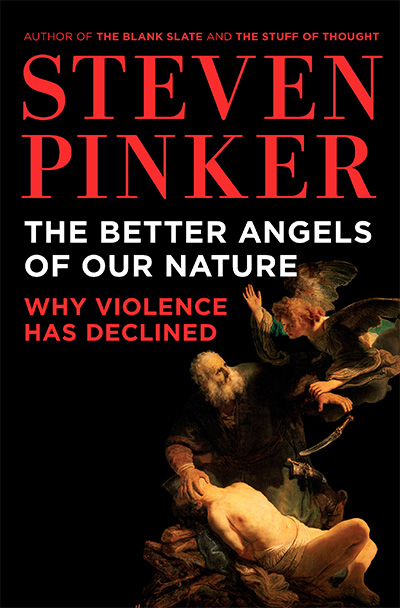 Edward Snowden’s revelations call to mind George Orwell’s 1984.
Edward Snowden’s revelations call to mind George Orwell’s 1984.
When I was planning do a futurist review of 2013, I initially thought that I would just talk about some of the cool developments in technology and imagine how great things would be if they all panned out. But this techno-optimism only tells part of the story. Ramez Naam gave a great talk at Humanity+ 2012 criticizing bad futurism for ignoring economics and glossing over the downsides. Benjamin Bratton recently gave a TED talk criticizing TED, in which he pointed out that culture dictates how technology plays out in the real world. So as I review the year, I am going to try to address both the positives and negatives of some key economic, cultural, and technological developments of 2013.

One positive cultural narrative that caught my attention recently was presented by Stephen Pinker in his book, The Better Angels of Our Nature. Pinker makes a convincing case that humans have become less and less violent over the years. Even the bloody 20th century had fewer war deaths per capita than previous eras. However, one big idea in Pinker’s theory (which he borrowed from Hobbes) is that as states rise, violence decreases, because the state assumes a monopoly on the use of force. This discourages individuals from hurting others for their own gain. The problem is that the power of the state can grow too much. As Edward Snowden has revealed, the US government has almost omniscient powers of surveillance. We effectively live in a panopticon of constant surveillance. We may be on a path toward a world with absolutely no crime, but where your every move is monitored by Big Brother and the PreCrime Police come and take you away before you are able to commit a crime.
The negative story of the economic decline of the US has also figured prominently in 2013. Wages are stagnant, unemployment is high, and wealth inequality is reaching medieval proportions. Yet, worldwide poverty seems to be at an all time low (if the World Bank numbers are to be believed). So I wonder if we rich Americans are biased in our view of economic decline. Maybe it’s a good thing for Americans to get marginally poorer if the rest of the world gets richer. But an even brighter vision is of economic growth where everyone can benefit as more human potential is tapped. As millions of people in places like China and Africa rise from abject poverty and are freed from disease, they will be able to learn, reach their full potential, and participate in the world economy.
Since I do love science and technology, let me indulge in some bright and dark notes from this year. On a downbeat, we are seeing more and more problems come to light with the current state of science. The bottom line is that many scientific papers are rubbish and cannot be reproduced. This may be due to bad incentives; scientists are rewarded more for flashy positive results than mundane or negative results. But a study that reveals a hypothesis to be flawed increases human knowledge more than a paper which falsely overstates a significant breakthrough,
Nonetheless, there were some technological developments worthy of note. Consider the CRISPR gene editing technique, which can very precisely modify genes using an immune strategy from bacteria. Conventional virus based therapies can add good genes, but cannot repair problem genes the way CRISPR can. George Church discussed this at the 2013 Foresight conference, and further studies have shown its potential to modify genes in mammals. Unlike many science stories that cause a big stir initially, but are never heard of again, this one seems like the real deal. This breakthrough may give the GMO industry an incredible new tool to customize organisms, possibly even humans. If it works in humans, many congenital diseases could be conquered. People may even be able to get modifications that make them more resistant to diabetes or Alzheimer’s. The dark pessimist in me worries that we may see humans modified without their knowledge or consent by overreaching governments. Or we may see the rise of a new elite that can outcompete the have-nots.

A deep learning AIs concept of faces and cats.
In the artificial intelligence world, we are seeing big breakthroughs in “deep learning.” This is a machine learning algorithm that somewhat mimics the neural networks found in brains. Google has used it to analyze videos and identify human faces and, of course, cats. This past year, AI researcher Andrew Ng built a much cheaper deep learning system using graphics processors (GPUs), so Google’s $1 million deep learning computer cluster could be matched by a $20,000 system. The fact that Facebook is jumping on board by snapping up their own deep learning guru makes me suspect that this is not a flash in the pan. Also, my favorite Bay Area AI researcher, Monica Anderson, seems to approve of this general approach to machine learning. This could be an incredibly powerful AI. The big downside of AI getting too powerful has been well explored from Frankenstein to The Terminator, so I won’t belabor this point; there are folks who are thinking deeply about how to prevent those scenarios. But one big upside of AI could be to help us sort through this overwhelming firehose of information that is growing all the time, so that we can make sense of this world and find solutions to problems.
In conclusion, 2013 had both positive and negative developments. Technologically, there were some amazing advancements, including the CRISPR gene editing technique and deep learning AI. Economically, there emerged a complex story of economic stagnation in developed nations, paired with a reduction in poverty in the developing world. Politically, we saw some chilling examples of government overreach in surveillance. My hope is that futurists will expand their horizons beyond the technological, to think about the best role for our government going forward, and the best paths toward greater economic inclusion. The optimists among us should take heed of the pessimists’ warnings. For their part, the pessimists should take a moment to pause in their dire predictions and ask themselves, “Yes, this could all go terribly awry, but what do I think should happen?” At the end of the day, if we take into account all the competing forces that define what is possible, I do believe we can chart a course toward progress.
[UPDATE 2/10/2014]
I actually wrote up a presentation for the first Transhuman Visions conference on this topic and those notes are here: http://bit.ly/tv-oak.
I attended Foresight this year and some scientists were asserting that the reproducibility problem is based on not recognizing the “control parameters” of the experiments in question. There are some crucial parts of the experiment that the grad students or lab techs are taking for granted or not noticing and then not recording properly.
Also, I am taking Pinker’s modern murder decline numbers with a grain of salt after Annissimov pointed out that modern medicine might be masking the violence of modern times by saving victims that would have otherwise died. Of course, modern guns make it easier to attack others, so that should be taken into account, not to mention that attempted murders have probably gone down, but nonetheless, these are valid questions around Pinker’s trends.
 I am halfway through Influx now and in some ways it continues a central theme found in Suarez’s work. He is is concerned about the way technology can concentrate power into fewer and fewer hands as it progresses. His novel deals with the stagnation of innovation idea by suggesting that innovation has actually occurred, but that it is continually harvested and hidden by a secret government organization that is intent on maintaining social order. He also suggests that an attempt to create superhuman AI capable of innovative insights, but lacking in free will, is an abomination. It represents for him a sort of cybernetic slavery that could put unthinkable power into the hands of a single person.
I am halfway through Influx now and in some ways it continues a central theme found in Suarez’s work. He is is concerned about the way technology can concentrate power into fewer and fewer hands as it progresses. His novel deals with the stagnation of innovation idea by suggesting that innovation has actually occurred, but that it is continually harvested and hidden by a secret government organization that is intent on maintaining social order. He also suggests that an attempt to create superhuman AI capable of innovative insights, but lacking in free will, is an abomination. It represents for him a sort of cybernetic slavery that could put unthinkable power into the hands of a single person. I haven’t read Andy Weir’s book, The Martian, but his reading was very compelling. He tells the story of an astronaut stranded on Mars in the form of smart-assed entries into a mission log. Weir is a computer programmer and was obsessed with getting all of the technical details correct in order to make the story scientifically feasible. He credits this adherence to scientific accuracy for providing him with many unexpected plot twists as he thought through the scenario one step at a time. His book has received a good amount of positive press and I look forward to reading it.
I haven’t read Andy Weir’s book, The Martian, but his reading was very compelling. He tells the story of an astronaut stranded on Mars in the form of smart-assed entries into a mission log. Weir is a computer programmer and was obsessed with getting all of the technical details correct in order to make the story scientifically feasible. He credits this adherence to scientific accuracy for providing him with many unexpected plot twists as he thought through the scenario one step at a time. His book has received a good amount of positive press and I look forward to reading it.